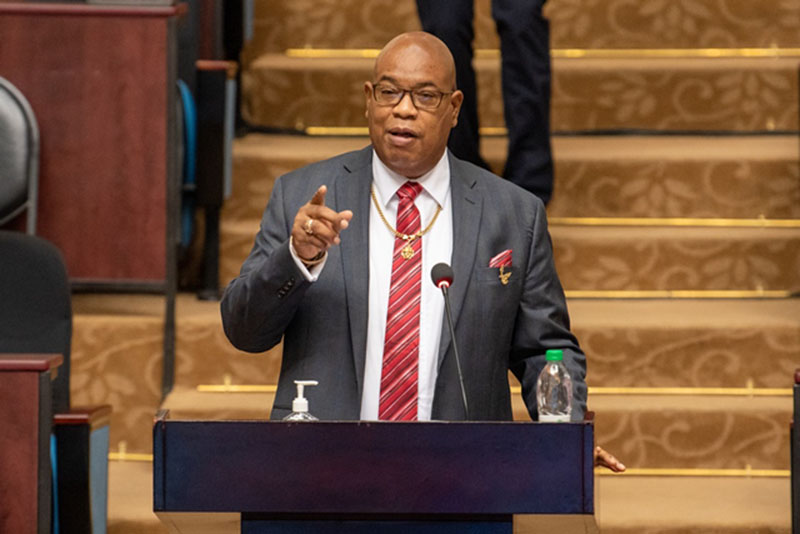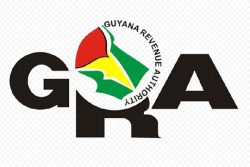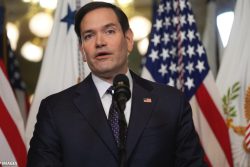Planned infrastructural investments under this year’s $552.9 billion budget will lay the foundation for modernisation, transformation and creation of sustainable prosperity for the future Guyana, Public Works Minister Juan Edghill has said.
Addressing the House during the budget debate last Thursday, the Minister said the investments in roads and bridges should not been seen as only providing infrastructural necessities but also as new opportunities for large scale farming, housing, tourism and other areas.
“We are making a corridor open to move Guyana into to the next leg of linking Linden to Lethem, eventually opening up to tens of millions of people in a new market in Northern Brazil. The road is leading so people can eat,” Edghill said before noting that infrastructural investments are opportunities for the prosperity of Guyana.
APNU+AFC Member of Parliament Sherod Duncan, who spoke before Edghill, had said “people cannot eat roads” as he criticized the budget for failing to meet the welfare needs of the people.
In response to Duncan’s commentary, Edghill said “you can’t eat roads, but without roads you can’t eat’ before adding that the budget also supports programmes to empower women and addresses the needs of vulnerable groups in the society.
The public works ministry has been allocated some $96.1 billion this year to execute infrastructural mega projects throughout the country. From the sum, $76.7B has been earmarked for the construction of roads and bridges.
Rapping the previous coalition government for failing to implement large projects, such as the Demerara Harbour Bridge and the Amaila Falls Hydropower projects, among others, Edghill said the opposition suffers from “megalophobia.”
“Every time something big is discussed they get scared. Amaila, the one project that would have already been benefitting Guyana, they scuttled it. It is too big for them to understand. So now they hear gas to shore, too big for them to understand. You hear $88 billion for infrastructure, too big for them to understand. You hear a budget of $552.9 billion, too big for them to understand,” he said to sounds of support from his colleagues on the government side of the House.
Edghill went on to state that his government will continue to make the necessary investments to propel the transformation and investments necessary for the country.
He stated that investments in the road network will add value to the developing tourism industry. According to the minister, when roads are constructed and kept at a standard, tourists have the opportunity to rent vehicles and explore the country.
“We have to be able to put in place the infrastructure to ensure the tourists who are coming here to rent a car to drive and see the country, there is proper road safety and there are proper roads to encourage that,” he added.
Edghill stressed that not only will the roads contribute positively to tourism but also to Guyanese from rural and urban Guyana. Pointing to road developments in the hinterland areas, he said Guyanese and particularly indigenous people will have the opportunities to connect with their communities.
“In Region Eight, we were able to give contracts to the communities to build the roads because you cannot just have the tractors, but you must be able to link the communities,” he said before pointing out that they are currently constructing a road to link regions Eight and Nine via Lethem, thereby providing further options of connectivity to other parts of Guyana.
Key allocations in the budget include provisions of $8.3 billion for the rehabilitation of the Corentyne Main Road from Palmyra to Crabwood Creek; $6 billion for the construction of the Linden-Mabura Hill Road; $3.4 billion for hinterland roads; $2.6 billion for the rehabilitation of the entire Soesdyke-Linden Highway; $2.3 billion for the East Bank-East Coast Demerara Road Linkage between Ogle and Eccles; $1.1 billion to complete the Sheriff Street – Mandela Road Network and Expansion Project.
The budgeted sum will also see some $15.2 billion being directed towards the construction and rehabilitation of additional urban and community roads.
Money has also been allocated for the construction of the new four-lane superhighway from Schoonord to Parika.
Meanwhile, Edghill’s predecessor, APNU+AFC parliamentarian David Patterson later told the House that while many of the projects have received praise, financing for key elements was missing.
“…but what has not been included in the budget 2021, the sum of $105 million was included for the studies, to transform Lethem airport into a regional hub, a new bridge at Wismar and the construction of a new stelling at Parika –after spending $102 million in 2021. These projects have vanished from budget 2022 without a single word. The government will be expending $2.6 billion in 2022 to upgrade the Linden-Soesdyke Highway, another $6 billion for the Linden-Mabura road,” he said before arguing that the government lacks the foresight to build a better bridge to connect the roadways.
He further questioned why with the additional sum required to fund the Ogle–Eccles four-lane highway, for which government now has to find approximately US$60 million, Guyanese contractors were barred from bidding. “No local companies were given the opportunity to bid on this increased tender scope. One would have expected that the government would have executed this project in two distinct phases, one for US$48 million, of which the India Contractors would be eligible to bid and the second for US$60M on which our local contractors would have had the opportunity to bid – so much for local content,” he lamented.
Ashoka Construction Company was announced as the bidder selected to construct the project. While the engineer’s estimate pegged the project at US$48.6 million, all the bids were over twice the cost.
Growing the middle class
Edghill also argued that the budget aims to develop the lives of middle class Guyanese.
“This budget has the measures designed to grow the middle class… it restores hope to Guyanese people and will bring them out of poverty” he said. “You cannot develop a country if you are not growing the middle class.”
The Public Works Minister used the recent announcement by the Guyana Revenue Authority of moving on to the PAC vehicle series as an example of the growth.
Under the budget, government has announced an increase in the tax threshold from $65,000 to $75,000, the move to reduce exercise tax on fuel from 20% to 10% and the introduction of having health care insurance to a value of $30,000 being non-taxable.
But countering Edghill’s position was Patterson, who said government’s budget had failed to meet the needs of the regular man despite government being aware of the rising cost of living.
He justified his reasoning by pointing to the “miserly maximum $2,800 increase” in the disposable income via the new tax threshold to the working class.
Patterson further stated that the budget prioritises “the private over the public, the rich over the poor, individual wealth over common national prosperity. Note the measures for private health and life insurance, yet the glaring absence of measures to help the National Insurance Scheme meet the needs of working-class citizens or public hospitals and schools keep their qualified and experienced staff.”
He added that nothing is aimed at helping the working poor getting to work, “not a single word on public ground transportation, just more roads.”









